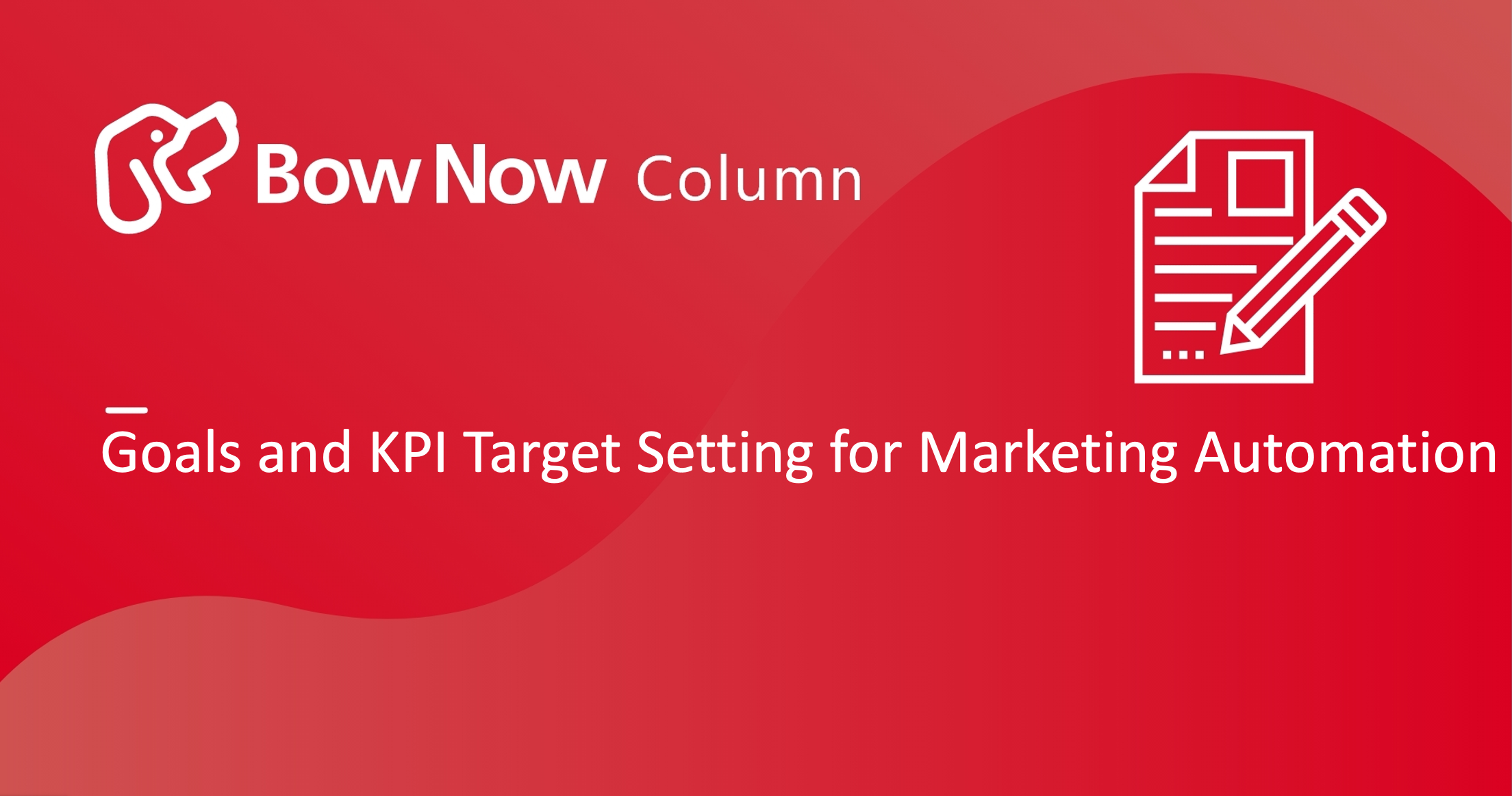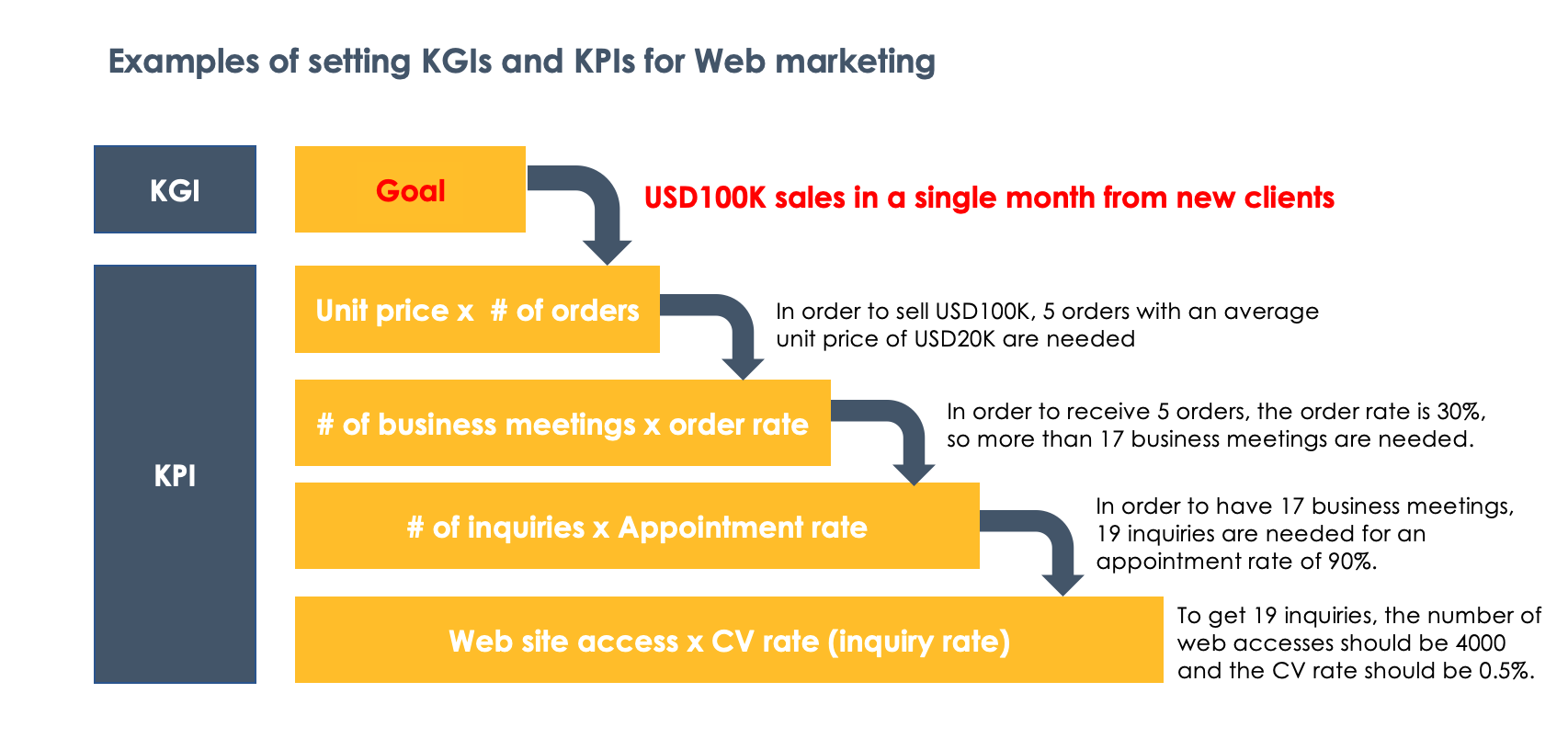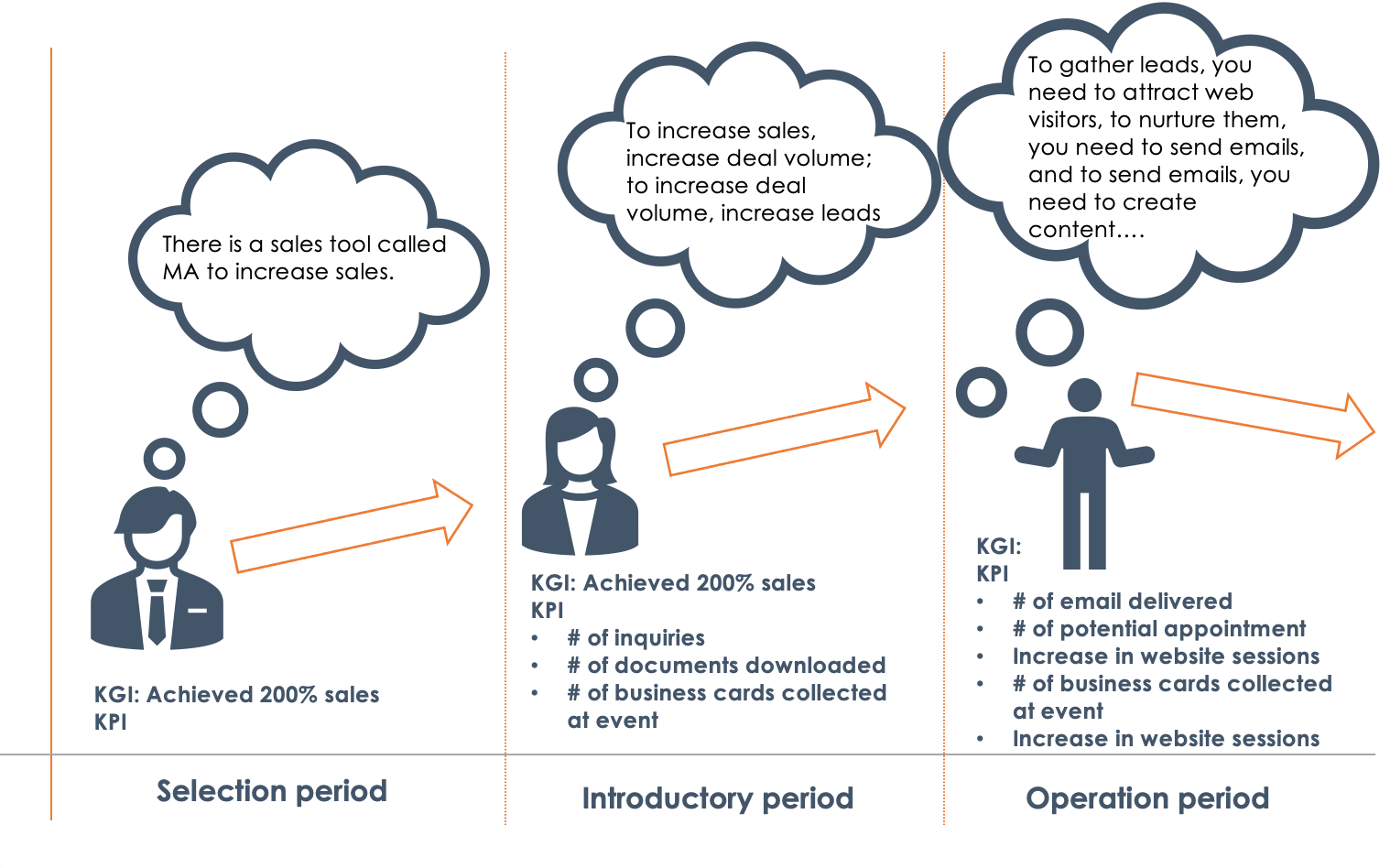Goals and KPI Target Setting for Marketing Automation

When introducing MA (Marketing Automation) tools, if the goals (KPI) of marketing activities are unclear, there is a risk of ineffective operation over the medium to long term. Therefore, it is necessary to set KPIs and KGIs as clear numerical targets in advance when operating MA tools.
This column explains the basic concept of setting KPIs and KGIs when operating MA tools.
・Introduced MA tool, howver only using it casually.
・The goals and objectives for MA tools have not been set
・Thinking about implementing MA in the future.
We hope this information will be helpful to you in setting KPIs and KGIs that meet your business goals and improve the efficiency of your marketing activities.
Table of Contents
1: The Purpose of Introducing MA (Marketing Automation) Tools
3: The Examples of MA failures caused by not setting KPI (Goal)
4: The Example of KGI for MA (Marketing Automation) tool operation
5: The Examples of KPIs (target indicators) for MA(Marketing Automation) tool operation
6: The Key points when setting KPI/KGI for MA (Marketing Automation) tool operation
7: The secret of MA success starts with setting appropriate KGI and KPI (goals)
The Purpose of Introducing MA (Marketing Automation) Tools
The objectives of implementing a marketing automation (MA) tool can be broadly summed up as "improving profits. Focusing on specific objectives, the following four points can generally be considered.
- Improved productivity of deal generation activities (automation of sales list creation, hot lead extraction, etc.)
- Increase in the number of business negotiations (number of deals passed to the sales division)
- Improvement of the quality of generated business negotiations (passed deals)
- Effective use of past leads through lead nurturing
The weight of these objectives will vary depending on "which departments will use it" and "how much budget and resources are available." When introducing MA tools, KPI/KGI will be considered in combination with the above four elements.
In order to set KPI and KGI that best suit your company's needs, it is important to clarify the purpose for which you are implementing MA tools in the first place.
What are KPI and KGI?
For effective use of MA (Marketing Automation) tools, let's take a moment to review the definitions of "KPI" and "KGI," which are indicators for measuring results in Web marketing. Roughly speaking, "KGI" is the ultimate business goal, and "KPI" is positioned as an intermediate goal to achieve "KGI. The specific definitions are as follows.
■What is KGI?
KGI (Key Goal Indicator) is directly translated as "Key Goal Achievement Indicator," and in layman's terms, it is the important goal (end goal) to be aimed for.
In order to clarify whether or not the goal has been achieved, it is common to set numerical elements as KGIs. Specific numerical values such as "sales" or "share ratio," or goals such as "acquire 0 new potential customers from the Web" are often set as KGIs.
■What is KPI
KPI (Key Performance Indicator), which translates directly to "Key Performance Indicator," is a simple way of saying "an indicator of progress toward a goal. It is an indicator that serves as an intermediate point toward the ultimate goal (KGI), and is based on the image of a tree of multiple KPIs that are sub-goals under the KGI, which is the major goal.
KPIs often include specific numbers such as "number of accesses" and "number of inquiries," as well as goals such as "increase the number of page views on the website to 0 or more.
The Examples of MA failures caused by not setting KPI(Goal)
Not setting KGI and KPI in the operation of MA (Marketing Automation) tools leads to an inability to properly evaluate your company's marketing activities.
Without setting KGI and KPI, it is impossible to objectively grasp what and how effective each action was. This makes it impossible to have a "reproducible success scenario," which is said to be one of the conditions for sound corporate activities, and the entire marketing program may end in failure over the medium to long term. In addition, because the success criteria become unclear, the cost-effectiveness of MA tools also tends to become ambiguous.
If KGI and KPI are set for the operation of MA tools, it will be possible to visualize which processes have been effective and how, and information sharing among related parties will be more effective. Especially for BtoB companies, it is recommended to set KGI and KPI in advance when introducing MA tools in order to properly visualize their business processes and clarify cost-effectiveness.
Thought and emotional movement in each phase of MA tool implementation

The Example of KGI for MA(Marketing Automation) to tool operation
KGI when operating MA (Marketing Automation) tools are set as follows. In most cases, the KGI is set as the overall marketing sales amount. Or, since the role of MA tools (marketing tools) is to create more effective business negotiations more efficiently, the number of business negotiations may be set as a KGI.
- The Sales generated by marketing activities
- The Percentage of sales generated from marketing activities
- The Average unit price and LTV (customer lifetime value) of orders generated by the marketing department
- The Number of business negotiations generated by marketing activities
As you may have noticed, collaboration among departments is essential to achieving KGIs for MA tools. If the marketing department simply increases the number of business meetings, it is not possible to measure whether or not this leads to sales, so it is important to have a solid measurement system in place.
The Examples of KPIs (target indicators) for MA (Marketing Automation) tool operation
The KPI for the operation of MA (Marketing Automation) tools are set as follows. The indicators to be set will vary depending on which department uses the MA (Marketing Automation) tool.
- # of business meetings generated by marketing activities (number of deals passed to sales)
- % of deals passed to sales and percentage of orders received
- # of business meetings generated by lead nurturing
- # of status increases and rank increase rates for users of a particular status (rank)
- # of leads held
- # of applications for specific campaigns (e.g., events, demonstration participation, etc.)
- # of leads acquired from intermediate conversions (e.g., white papers)
- Email open rate
- URL click rate of users who opened the email
- CVR (conversion rate) of users who open the email
The following KPIs are also necessary indicators if an inside sales department is set up to handle the approach to acquired inquiries, rather than a sales representative to handle the charge.
- # of MQLs passing from Marketing to Inside Sales
- # of inside sales calls
- Inside Sales Appointment Acquisition Rate
The Key points when setting KPI/KGI for MA (Marketing Automation) tool operation
Finally, here are some key points for setting KGI and KPI in MA tools.
■Set up something quantifiable
A common mistake when setting KGIs/KPIs is to make them non-quantitative.
For example, in a restaurant, if the KGI is a non-quantifiable goal such as "increase sales," the KPI will be "increase the number of orders for popular menu items" or "increase the number of repeat customers," and it will be unclear what conditions are required to consider the KGI or KPI to have been achieved. KPIs should be accompanied by quantitative and measurable values with a view to verifying the effectiveness of the measures.
■Set KPI that is linked to KGIs
KPIs must be linked to the ultimate goal, the KGI, and a causal relationship is required between them; when a KPI tree is developed, it must be designed so that the causal relationship between KPIs and KGIs can be proven by the four arithmetic operations for each KPI toward the KGI. The same causal relationship is required between upper-level KPIs and lower-level KPIs.
For example, in the case of KPIs for smartphone applications and games, it is not clear that "an increase in the login rate or number of shares will increase the retention rate" is a causal relationship. In this case, the login rate and the number of shares are merely "factors that may influence the increase in the retention rate.
If a causal relationship with the upper-level KPI factor (in this case, the retention rate) can be proven through repeated hypothesis testing using the four arithmetic rules, it can be determined that the new KPI is the right value to track.
Although some elements of the KPI tree and logic tree are similar, they should be distinguished and understood.
■Do not make the hierarchy too deep
KPIs can be set for any service, but the structure of the KPI tree can become complicated as multiple KPIs are set, making it difficult to track their effectiveness. The role of marketing automation tools is to efficiently increase the number of business meetings that lead to sales. When considering KPI elements, one criterion that can be used is "Is it necessary to track that item (that number) on a daily basis?
■Don't use only the webmaster or marketing department to do the watch
Web marketing-related KGI and KPI can be very relevant to sales and related departments. Therefore, not only the main department in charge but also related departments should be interested in the indicators and sometimes share their opinions to make improvements.
The opinions of sales and customer support staff, who are familiar with customer feedback, are especially useful when it comes to the content of the content. It is recommended that you proactively incorporate their opinions and make improvements, such as what kind of content will be read and what kind of content will encourage downloading.
The secret of MA success starts with setting appropriate KGI and KPI (Goals)
It is extremely important to set and review KPIs and KGIs in marketing and sales activities, not only when implementing and operating MA (Marketing Automation).
If marketing activities are conducted without setting KGIs, it becomes unclear where the activities are headed and what issues they are intended to solve, and it may be difficult to make appropriate decisions when determining and scrutinizing measures.
In addition, if marketing activities are conducted without setting KPIs, only the final results (KGI) will be used to measure effectiveness, and the timing for implementing the PDCA cycle for measures may be delayed significantly due to the ambiguity of "which issues have been improved by which activities". When operating MA tools, setting KPIs and KGIs will speed up the process of achieving goals and increase accuracy.
However, if the key goal setting is not done properly, the measures may become blurred. If you have any questions about how to operate and utilize MA tools, please contact a BowNow consultant.
※PDCA......An abbreviation for Plan→Do→Check→Action. In marketing, it refers to the concept of executing operations by repeating the cycle of "plan, do, evaluate, and further improve.


.jpg)
.jpg)
.jpg)


